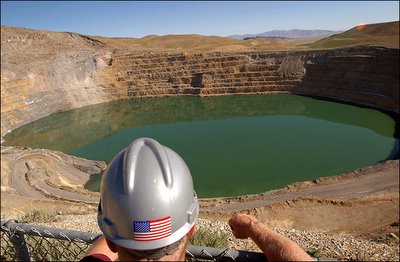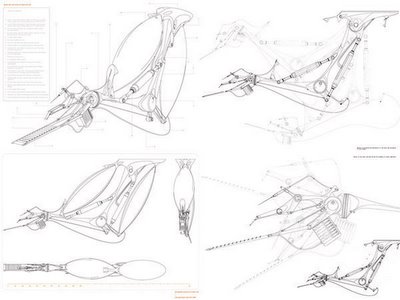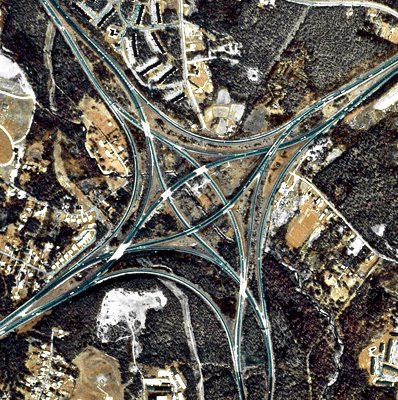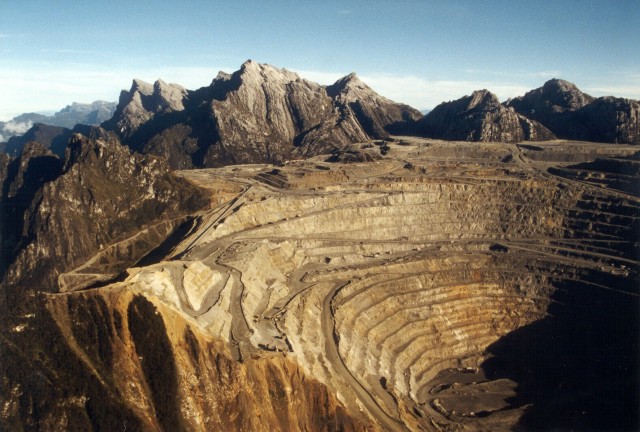
[Image: G.B. Piranesi, from the endlessly stimulating Complete Etchings].
Happy 2006…
Architectural Conjecture | Urban Speculation | Landscape Futures

[Image: G.B. Piranesi, from the endlessly stimulating Complete Etchings].
Happy 2006…

A series of articles on gold mining continues again at the New York Times, this time focusing on the state of Nevada’s groundwater.
“Nearly 10 million gallons a day draining away in the driest state in the nation… is just one of the many strange byproducts of Nevada’s tangled love affair with gold.”


[Images: Barrick‘s Goldstrike Mine, Nevada; all photos by Ashley Gilbertson/New York Times].
“Large-scale open-pit mining takes a lot of water, millions of gallons, mostly to dilute the cyanide that miners use to soak their ore and separate its microscopic bits of gold.” This, in tandem with mass pumping and the use of settling ponds, “could change both the quantity and quality of the groundwater, and even the shape of the aquifer.”

Nevada, however, seems to have escaped the attention of the environmental movement: “‘Nevada is mostly not prized by environmentalists,’ said John D. Leshy, who was the top lawyer for the Department of the Interior in the Clinton administration. ‘Nevada is being written off as a sacrifice area for gold.'”
(For more information see the actual article; and for a bit on gold in Indonesia, see BLDGBLOG’s earlier post).

[Image: Philipp Scholz Rittermann].
I scanned this interior view of a ship’s hull from a postcard I received yesterday. The voluminous, cathedral-like reinforced buttressing of the ship’s inner hull is all the more remarkable when you realize that this is the Exxon Valdez Under Construction.
Do future catastrophes offer hints in the details of the past?
(Thanks, Dan).
BLDGBLOG’s year-end look at cool student projects continues now with the Scrap Lung by Russell Pearce, winner of a Serjeant Award at this year’s Royal Institute of British Architects’ President’s Medals ceremony.


The project comes with these awesome little machine-diagrams –

– that show “hydro-arms… constructed from degrading machinery.”

It then proceeds through a series of exquisite mechanical studies illustrating “the motion of canal pumps and grapple cranes across the envelope of the architecture” –



– before framing the spatial realization of the ultimate form (a “degrading membrane, leached with iron oxide”), in the process demonstrating how the building will be used and inhabited.


Pearce’s design statement includes the following rather cryptic description: “Conversations formed amongst degrading machinery and hydrolysis limbs, etching time based vectors into their tissue and leaching iron oxide poetically across the architectural membrane. Capillaries of canal fluid percolate through its skin, chemically distilled, generating energy to clean, paint, heat, and breathe new temporary fabrics towards the city.”
It’s architecture come to life, breathing itself through a scrap lung.
Someone sign this man a film contract.
(Spotted via Archinect).
Northern Baltimore’s I-95/695 highway interchange is a “topological masterpiece,” and its superb “mathematical aesthetics” might just save it from being destroyed.
 [Image: “I was in a web of braided highways.” New Scientist].
[Image: “I was in a web of braided highways.” New Scientist].
“In the spring issue of The Mathematical Intelligencer, Michael Kleber, a topologist at MIT, waxed enthusiastic about [the interchange’s] ‘non-trivial braiding‘: while it is possible to just lift I-95 up and away from I-695, the northbound lane of I-95 braids both over, and then under, the southbound lane, making it impossible to pull them apart without cutting one of the lanes.”
 However, those simultaneous right/left exits don’t seem to be helping with traffic flow, and the system’s moving circular symmetry may soon be traded-in for something far simpler.
However, those simultaneous right/left exits don’t seem to be helping with traffic flow, and the system’s moving circular symmetry may soon be traded-in for something far simpler.
“I don’t want to encourage more cars onto the roads,” the New Scientist writes, “but if topology and beauty mean anything to you, get out there and enjoy I-95/695 now. It may soon be too late.”
 This leads me to wonder, of course, if you could take-over the U.S. Department of Transportation, and rebuild the nation’s highway infrastructure as a massive textbook in driveable knot theory.
This leads me to wonder, of course, if you could take-over the U.S. Department of Transportation, and rebuild the nation’s highway infrastructure as a massive textbook in driveable knot theory.
Seattle to Chicago, you drive achiral knots; Los Angeles to Phoenix, trefoils; New York to Miami, Brunnian links; while the most complicated ones are saved for a private highway system built between Washington DC and Denver.
All the tunnels of Manhattan, recurved and cross-torqued through themselves, with some so maddening only postgraduate researchers can find their way out of the city.
A new Olympic sport: driving the New York knots.
(Earlier: BLDGBLOG’s Wormholes).

“Venice has got a very different sound. It’s very interesting, when you’re there, you always hear some kind of hum, like from far away, but also people talking, and you never know if it’s in the next apartment or if it’s 400 metres away, because the labyrinth of the houses works as an amplifying system somehow.”
Somehow, BLDGBLOG has just won the title of Best Urban Architecture Blog over at Gridskipper… Leading to open, if excited, puzzlement.

Well, thank you if you voted; but if you’re new to this site and want to see what there is to do here, quickly, a narrative table of contents reappears below. Click through at your leisure – then forward to the BBC…
Meanwhile, don’t forget the world’s other – and quite possibly better – architecture blogs, including Pruned, gravestmor, Inhabitat, Land+Living, Daily Dose, Brand Avenue, Interactive Architecture dot Org (and many, many, many others); then there’s Régine, winner of Best Urban Arts Blog for the increasingly better-than-everything we make money not art. (And don’t forget Archinect).
Anyway, thanks again, be in touch, come back often, and here are the goods:

Where Gothic cathedrals go to die, on the beaches of an equatorial island!
Rollerskating alone at night through underground knots!
The world’s largest diamond mine!
Singing icebergs, as the arched foundations of London groan!
A man’s apartment exactly reproduced using colorful nylon sheets!
Lunar electricity!

The drains, tunnels, and self-connected topologies of underground London!
Entire cities snowing diamonds from Baroque domes!
A temporary public park – complete with bench and parking meter!
The poet Shelley sets sail for a volcanic archipelago made entirely of glass!
Beautiful maps!
A London superstadium full of ring magnets will capture the Northern Lights!

The churches of Christopher Wren, transformed into a geomagnetic harddrive!
Proto-terrestrial landscapes swarming with alien bacteria!
James Bond thwarts a San Franciscan attempt at tectonic warfare!
An abandoned island off the coast of Japan!
The suburbs, raw mounds, and earthworks before construction arrives!
The internal volume of Notre-Dame, Paris, carved into the surface of the moon!

Meat!
The landscape architecture of Hell, its subsurface faults and magmatic geology!
Why not live inside your garage?
The robotic, neverending cinema of Los Angeles traffic control!
The house of landslides, filled with geese!
Measuring astronomy – solstice and stars – with a city modeled on Stonehenge!

The averaged images of suburban ennui!
Cake!
New Arctic seaways promise Lovecraftian visions to come!
Famous architecture, blurred!
Photographs of Chernobyl, including an abandoned alphabet!
The Earth in 7.5 billion years!

Fossilized cities!
The art of reforesting continents through tree bombs!
The deserts of the world are musical instruments!
The wonderfully weird, self-observing urban world of CCTV!
Sci-fi instant cities built above working limeworks pits!
WWII British sound mirrors used to musicalize mountain storms!

All hell is breaking loose in middle America!
San Jellocisco!
Catching near-earth asteroids using a gigantic baseball mit!
An inflatable hotel – in deep space!
Folk maps of Brooklyn’s Gowanus Canal!
Houses, churches, places to hang: it’s the afterlife of the Quonset hut!

A man jumps from a balloon, free-falls 20 miles through the stratosphere, and captures the whole thing on tape!
King Kong!
Complicated pipe networks are plugged into a volcano to extrude cathedrals directly from the earth!
Huge, interconnected white towers in the middle of Beijing!
An Indonesian mine and the technicolor stalactites it will form in a million years!
Amazing tree houses by Andrew Maynard!

Happy new year. (And thanks again).
In 1960, U.S. Air Force pilot Joe Kittinger flew 30km straight up into the sky using a pressurized, high-altitude balloon. This very nearly made him the first man in space.
He then jumped.

Kittinger free-fell for over twenty kilometers – at which point he was moving so fast he broke the sound barrier.

He had all but left the earth’s atmosphere; the sky around him was pitch black; he could see the outlines of entire continents; and the haiku-like abstraction of his available reference points – earth, balloon, space – made it impossible to tell if he was really falling.
Luckily, there’s a film.

[Image: Songhua River, NASA Earth Observatory].

[Image: Algodones Dunefield, California].
While looking for images for the previous post – like this one – I got lost in an amazing website full of unbelievably beautiful landscape images: it’s NASA’s Earth Observatory page.
Here’s a representative sampling.



[Images: Lake Nasser; Colorado River Delta; and the Taklimakan Desert].
There are roughly 1800 other images to choose from, and it appears to be updated daily – good luck.
There’s a huge new article in The New York Times about gold mining in Papua New Guinea and “the intricate web of political and military ties” that keep it moving.
 [Image: “Freeport-McMoRan Copper and Gold, an American company, operates this mine in the easternmost province of Indonesia, on the island of New Guinea.” Courtesy of the New York Times].
[Image: “Freeport-McMoRan Copper and Gold, an American company, operates this mine in the easternmost province of Indonesia, on the island of New Guinea.” Courtesy of the New York Times].
As the article describes it, the Freeport-McMoRan mine is like a dizzying combination of the novels of J.G. Ballard, Fritz Lang’s Metropolis, and a Werner Herzog film: “Freeport has built what amounts to an entirely new society and economy, all of its own making. Where nary a road existed, Freeport, with the help of the San Francisco-based construction company Bechtel, built virtually every stitch of infrastructure over impossible terrain in engineering feats that it boasts are unparalleled on the planet.”
The result is “a 21st-century version of the old company town, built on a scale unique even by the standards of modern mega-mining.”
It’s a geotechnician’s utopia – populated by construction engineers, former CIA operatives, and Indonesian military attachés.
 In the process, Freeport has literally created a new landscape, a down-river hydrological earthworks sculpture made entirely of poisonous mine tailings.
In the process, Freeport has literally created a new landscape, a down-river hydrological earthworks sculpture made entirely of poisonous mine tailings.
By “Freeport’s own estimates,” we read, the mine “will generate an estimated six billion tons of waste before it is through – more than twice as much earth as was excavated for the Panama Canal. Much of that waste has already been dumped in the mountains surrounding the mine or down a system of rivers that descends steeply onto the island’s low-lying wetlands.”
Incredibly, “the waste rock in the highlands, 900 feet deep in places, now covers about three square miles.” It is “accumulating at a rate of some 700,000 tons a day.”
At that rate, a whole new continental plate could be created.
 [Image: A view of the mine, by Kutztown University geologist Kurt Friehauf].
[Image: A view of the mine, by Kutztown University geologist Kurt Friehauf].
Another danger, however – though I find this fascinating – is that “the waste rock atop the mountain will trickle out acids into the honeycomb of caverns and caves beneath the mine in a wet climate that gets up to 12 feet of rain a year.”
Before my morals kick in, I’m left stunned by a vision of technicolor stalactites growing drip by drip in the darkness, stretching toward pools of iridescent pollution slowly solidifying into rock. What, in a million years, will these caves look like? Will anyone be around to spelunk them?
Could you deliberately use metallic pollution to color rocks, then use those rocks as a building material?
Bank lobbies floored with examples of a new geology. Using caves as a kind of rock-farm; harvesting for color.
In any case, the article is totally fascinating, whether it moves you to campaign against pollution or invest in gold mine companies; and there are two prequels to it, as well: here and here.
(See also BLDGBLOG’s Monitor Mine, Bingham Pit, Utah, and the World’s largest diamond mine, as well as some cool limeworks photographs).